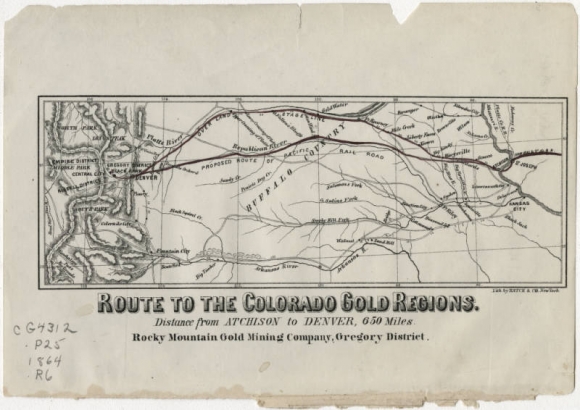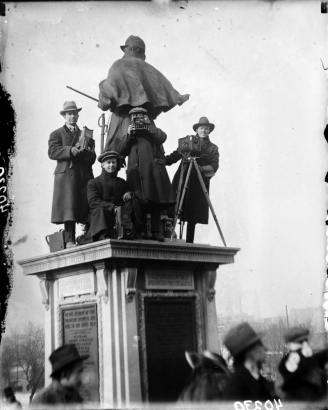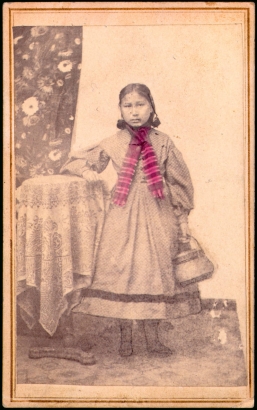Anyone who has driven from Denver to Kansas City and beyond knows the journey really begins somewhere east of Aurora, where our sprawling metropolis gives way to the Great Plains. As a child, and native of Denver, I often dreaded this annual summer adventure as my Kansas-born mother insisted my brother and I accompany her in our air conditioner-less station wagon. But that dread was quickly replaced with excitement to see my family (now fifth-generation Kansans), and an overwhelming and inexplicable sense of some special bond between my hometown of Denver, and her hometown of Atchison.
Now, as a librarian, researcher, and historical fiction author, I have a stronger sense of the historical reasons that may also underpin that sense of connection between our hometowns. Denver and Atchison have been connected by overland routes for as long as the two have existed. As this 1864 map shows, our drive approximated the trails Denver's early pioneers took, often embarking from Atchison. We were following in the footsteps of the people historian Thomas Noel described in his forward to The 59ers as "gold grubbers, town puffers, purring prostitutes, glinty eyed gamblers and ink smeared journalists." (Much of it anyway. If you take a close look you'll see Interstate 70 actually runs along a section of empty plains east of where the Smoky Hill Trail on this map diverts south. Known sometimes as the "Middle Route," and in parts the "Starvation Trail," it purported to shave 100 miles off the journey, but as early Rocky Mountain News articles and an autobiography by Daniel Blue attests, it lacked wood, water, supply stations and clear markings. Starvation, and even cannibalism, were the result).
And if we take a look at a slightly earlier map, perhaps this one from 1859, we see that Denver and all of eastern Colorado was at the time a part of Kansas Territory. Despite residents of Denver lobbying for the creation of Jefferson Territory as early as 1859, which Congress never recognized, this part of Colorado was a part of Kansas until 1861. A complicated series of negotiations and compromises in the territory, and between it and Washington, resulted in the modern borders of Kansas and the creation of Colorado Territory. A matter of controversy, certainly, but by no means was this geographic consideration the most contentious in the region in the 1850s.
Slavery, and whether or not it would be allowed in the West, tore Kansas Territory apart beginning with its creation in 1854. Questioned elections, fake news, xenophobia, racism, sexism and violence characterized life in territorial Kansas. Though the first Denverites were perhaps more concerned with gold, they were residents of a territory obsessed with these issues,and how they related to slavery. (They were also illegally squatting on Arapaho and Cheyenne lands, by the way). And eventually, of course, "Bleeding Kansas" spread and the entire nation began to succumb to the same fate in the Civil War.
The Soldier's Monument in Denver's Civic Center Park, seen here in the 1920s, was erected in memory of those men from newly established Colorado Territory who volunteered during the Civil War. This and similar monuments throughout the country remind us, I think, not only of their sacrifices but the underlying reasons for them: the fact slavery is a significant part of our history; that it took a brutal war to end it; and, in my mind, the necessary implication that for generations, Americans were unable to do so through less violent means. Looking out over the park from the steps of the capitol, it is as if this man asks us to gaze back over time and remember.
In fact, the monument now reflects not only Civil War history, but the historiography that has emerged since its unveiling in 1909.
The last battle listed on the 1909 plaque on the statue is Sand Creek. What is now known to have been a macabre slaughter of defenseless Arapaho and Cheyenne families, was by many at the time considered a military engagement. That misrepresentation has now been noted on the monument—a new plaque has been installed that correctly identifies the Sand Creek Massacre for what it was. One, I think, that better honors the memory of this girl, a survivor of merciless violence.
I feel tied to the time and place of territorial Kansas for many reasons. The fact it is the heritage of my hometown of Denver, and my mother's of Atchison, is a big part of it. But so are these issues of division. The similarities of our time and theirs are disconcertingly apparent. Elections where many feel unrepresented, rancorous public discourse, economic pressure, and charged social issues involving race, immigration, and differing perceptions of what it is to be "American" are shared experiences between us and the residents of our region living in the 1850s. I think we can all empathize with them 175 years later. And, I hope, learn from them.
In this, we find libraries' invaluable contribution to our exceedingly complex society. The resources provided by the Western History Collection ensure we can study our past. And if we seek through honest study to understand it, that past can inform our behavior. We can only do that with strong public libraries.
So, what do the resources of our libraries teach us? What would those Kansans and early Coloradans tell us? I don't know, of course, but in their history there are certainly lessons about the importance of civil rights, equality under the law, and the terrible cost of violence. The violence that arises when we refuse to compromise or empathize. When we don't listen.
The avoidable violence that arises when we are silent in the face of injustice. The violence we make possible when we vilify one another.
Jack Marshall Maness is a librarian, professor, and author of the novels Song of the Jayhawk and Where Waters Converge.





Comments
Lovely, poignant essay. Thank
Lovely, poignant essay. Thank you, Jack.
Many thanks Jim!
Many thanks Jim!
A sidebar to this history, in
A sidebar to this history, in 1864 Congress offered statehood to Colorado, Nebraska, and Nevada territories. Colorado voted for territory status over statehood. Nebraska couldn't agree on a Constitution. Only Nev. met the requirements for statehood at this time. ( A Republican Congress hoped these proposed states would vote for Lincoln in the 1864 Presidential election.)
A fascinating sidebar, WRT.
A fascinating sidebar, WRT. Thanks for sharing.
Well done, touching and
Well done, touching and appropriate. Thank you.
Thank you! Answered questions
Thank you! Answered questions I had about my ancestors trip to Denver in 1864 !
This is incredibly relevant
This is incredibly relevant to this exact time in history. Thank you for opening our eyes.
Incredibly informative and…
Incredibly informative and well written. I thank you for sharing your knowledge. I moved to Kansas from Golden Colorado several years ago.
It took a while to adapt to the harsh Kansas winters. Financially it was a good move for me . I am still considered a transplant . The people here are not so welcoming to newcomers. I have come to love kansas I bought a house here something I could never do in Colorado .
Add new comment